January 22, 2010
Air Date: January 22, 2010
FULL SHOW
SEGMENTS
Rebuilding Haiti from the Roots Up
View the page for this story
Haiti’s long-standing environmental crisis has amplified its current humanitarian crisis. Marc Levy, deputy director of the Center for International Earth Science Information Network at Columbia University, had been working to alleviate poverty, hunger and landslide vulnerability by restoring the island nation’s ecosystem. He tells host Jeff Young what Port-au-Prince was like during the earthquake and how national rebuilding efforts need to include an ecological plan. (07:15)
Republican Win Dims Hope for Climate Bill
View the page for this story
Scott Brown's surprise victory in the Massachusetts Senator race hasn't just upset plans to pass health care reform, it's also made climate change legislation more unlikely. Host Jeff Young talks with Darren Samuelsohn, senior reporter for Environment & Energy Daily, about what the new Senate math will mean for efforts to cap greenhouse gas emissions. (04:15)
A Year In, New Ideas for Obama
View the page for this story
Many environmentalists and politicians have long looked to cap and trade as a way to control carbon emissions by making them more expensive. But not all environmental groups approve of the mechanism. Michael Shellenberger of the Breakthrough Institute explains to host Jeff Young why technological advancements, and not carbon restrictions, are the key to controlling climate change. (06:10)
Cool Fix for a Hot Planet
/ Emily GuerinView the page for this story
A teacher in Taiwan has a project for his students: construct a schoolhouse with papercrete - a mixture of recycled paper, water and a little bit of concrete. Living on Earth's Emily Guerin reports on this inexpensive, relatively green material. (02:10)
Good Fish, Bad Fish
View the page for this story
A new study by The Environmental Health Perspectives journal points out the dangers of persistent organic pollutants in farmed salmon. Yet the Monterey Bay Aquarium’s Seafood Watch Program just approved one kind of salmon farming. Host Jeff Young talks with Shelia Bowman of the Monterey Bay Aquarium about how one company is trying to clean up their tank. (06:00)
Long Live the Kingfisher
/ Mark Seth LenderView the page for this story
Salt Marsh Diary writer Mark Seth Lender moves by stealth to watch one of his favorite birds, the Kingfisher, as it readies itself to eat. (03:10)
Listener Letters
View the page for this story
LOE received lots of listener letters and calls in response to our holiday specials and story about car sounds of the future. We’ll hear some comments, criticisms and kudos. (02:30)
Walden by Haiku
View the page for this story
Henry David Thoreau’s Walden is one of the best-known works of American nature writing. His prose include images of nature, an emphasis on simplicity, a sense of aloneness, and the use of paradox - elements that are also present in haiku poetry. Noting these similarities, Penn State/Altoona Professor Ian Marshall took Thoreau’s prose and rewrote them into a series of haiku. He tells host Jeff Young talks about his process and why he decided to do this project. (10:00)
Remembering Ted Stanley
/ Steve CurwoodView the page for this story
Philanthropist Ted Stanley, namesake of the Living on Earth Studios, recently passed away. He was dedicated to supporting public radio and environmental causes, including cleaning up the Chesapeake Bay. Living on Earth’s Steve Curwood pays tribute to Ted Stanley. (03:00)
This week's EarthEar selection
listen /
download
Despite the frigid temperature, a group of musicians warm passersby along a pedestrian byway in Copenhagen's city center.
Show Credits and Funders
Show Transcript
HOST: Jeff Young
GUESTS: Mark Levy, Darren Samuelsohn, Michael Shellenberger, Sheila Bowman, Ian Marshall
ESSAYS: Mark Seth Lender, Steve Curwood
COOL FIX: Emily Guerin
(THEME)
YOUNG: From Public Radio International - this is Living on Earth. I’m Jeff Young. Helping Haiti rebuild from the earthquake and restore its ravaged landscape.
LEVY: This is a complete life-changing moment for absolutely every single Haitian and for every single person working in the country. Nobody can pretend that they can pick up the pieces where they left off.
YOUNG: Ecological restoration for a more resilient Haiti. Also, clean energy in President Obama’s first year. One critic says he put too much energy into a carbon cap and not enough money into new technology.
SHELLENBERGER: We didn’t get the personal computer through a cap-and-trade system on typewriters; we didn’t get the Internet by putting a telegraph tax or a fax tax. We create these new technologies and we make them cost competitive directly.
YOUNG: These stories and more this week on Living on Earth. Stick around.
[MUSIC: Boards Of Canada “Zoetrope” from “In A Beautiful Place Out In The Country” (Warp Records 2000)]
Rebuilding Haiti from the Roots Up

Dominican Red Cross attend to Jean Reneau Beoubuer in Cite Soleil. (Photo: Talia Frenkel, Courtesy of American Red Cross)
(THEME)
YOUNG: From the Jennifer and Ted Stanley Studios in Somerville, Massachusetts – this is Living on Earth. I’m Jeff Young. Since January 12th the world has watched in horror the news coming out of Haiti. The earthquake added unfathomable suffering to a nation already beset by poverty, political upheaval and environmental degradation. Columbia University political scientist Marc Levy was in Haiti when the earthquake hit--at the U.N. Development Program’s compound in Port-Au-Prince.
LEVY: I personally first thought that we were under armed attack. After ten seconds or so, it was fairly evident that we were experiencing an earthquake. Fortunately, where I was suffered only modest structural damage. The scene outside the compound was in stark contrast to what we were experiencing – very severe damage, cars crushed, buildings collapsed, lots of injuries, chaos. And so a lot of people were let in to be given immediate first aid – several hundred people eventually.

A man in front of the pile of rubble that once was the Université Caraibes. (Photo: Eric Quintero, Courtesy of IFRC)
YOUNG: Professor Levy is with Columbia’s Earth Institute, which is working with a U.N. program in Haiti motivated by the disastrous flooding during 2008’s tropical storms. The Haiti Regeneration Initiative aims to address the twin challenges of political strife and natural disaster and the ecological conditions that underlie those problems.
LEVY: Haiti is a place that has experienced both political instability and natural disasters. This particular program was extremely ambitious – the aim was to get beyond the kind of patchwork, short-term, ad-hoc type of foreign aid that’s characterized the country in the past, and to think big, to think in light of the kind of new optimism that was present over the last year with regard to Haiti that we could really do something different. And the idea was to design principles that could be implemented that would achieve reforestation, lessening of the hurricane risk, and improvements in soil fertility across the entire country.
YOUNG: What becomes now of those programs like the one you were engaged in that were starting to show some early green shoots, some early signs of promise?

Dominican Red Cross attend to Jean Reneau Beoubuer in Cite Soleil. (Photo: Talia Frenkel, Courtesy of American Red Cross)
LEVY: Clearly, everything is different now; nobody can pretend that they can pick up the pieces where they left off. This is a complete life-changing moment for absolutely every single Haitian, and for every single person working in the country.
In our particular case, the connections between the urban poor and the countryside are so strong, and the connections between the deforestation, soil erosion and flooding risks and these seismic risks are so strong that we think the overall framework is still deeply relevant – we’re just implementing it in different ways.
YOUNG: How did Haiti’s ecosystem become so degraded anyway? Dominican Republic, their neighbor there on Hispaniola, there’s a stark difference written in the trees, themselves. The political boundary is visible in trees on one side and the lack of them on the other. How did Haiti end up on the path it did; and what lessons should we take from that as we look ahead?
LEVY: The initial colonial history was one in which a very large number of slaves were brought in by the French, so that from the very start the population density in Haiti was much larger than in the Dominican Republic.
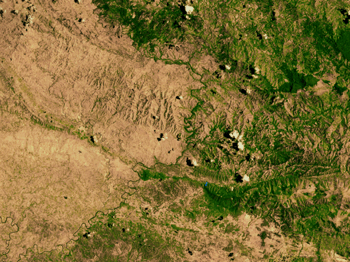
The visible border between Haiti and the Domincan Republic. (Courtesy of NASA/Goddard Space Flight Center Scientific Visualization Studio)
And they engaged in cultivation practices that resulted in significant and fast deforestation, lots of trees exported back to Europe, and then when the French were thrown out, the Haitians were left with a very large population with a very weak resource base from which any group of people would find it very hard to recover.
YOUNG: How does Haiti’s ongoing environmental crisis feed into the humanitarian crisis that we see now?

The United Nations on a search-and-rescue mission of its headquarters in Port-au-Prince. (Photo: Logan Abassi)
LEVY: Well, in a number of ways. One is simply that the country is extremely poor – two thirds or so of the country still makes its living in the countryside, but the countryside is extremely ill-suited towards providing livelihoods for people because of the centuries of mismanagement.
The corn, which is one of the basic crops, has got a yield in Haiti of 800 kilograms per hectare, which is extremely low – among the very lowest in the entire world, it’s about half of what it is in the rest of South America, it’s about a tenth of what it is in the United States.
YOUNG: So, if we have upwards of 60 percent of Haitians who depend on the land, how can something directed at environment restoration help make their dependence on the land more sustainable?
LEVY: Well, what’s going on now is that they’re getting less and less value from the land year after year. The trees are getting cut down; they suffer regular traumatic damage from the storms. We visited an area in the southeast of the country last year, and numerous families that we talked to had their entire crop wiped out during the 2008 hurricanes. So, by reforesting, by channeling the stream so that the floods are less severe and the soil erosion is lessened, crop losses go down.
YOUNG: And, how does the relationship to the land affect what happens with the growth of the cities? I’m guessing people, their crop gets wiped out they may be left with no choice but to end up in, say, a shanty in Port-au-Prince?
LEVY: Yep, that’s exactly right. A number of the families responded to the 2008 disasters by moving into the cities. The reverse of what’s going on now. And that puts more pressure on the cities where the jobs are very scarce, and so they move from one type of misery to another.
YOUNG: You know, it was not that long ago, just under two years ago, we were talking about disastrous flooding in Haiti linked to deforestation and tropical storms hitting the island. Chances are many of the people displaced by this earthquake will remain displaced and in temporary shelters for months. Hurricane season is not that far away – how does that concern play into how you deal with the displaced people here?
LEVY: Well, I think there’s a couple of elements that are going to be very worrisome. One is that the countryside is already barely able to provide minimal living standards for people. And if some of these places become flooded with an increased number of people, and then those regions become stressed through severe storms or hurricanes, they could limit the coping capacity quite a bit, or put more people at risk.
Another danger is that you may get new settlements in places that people have historically avoided because they were dangerous. But people are potentially fleeing there because they feel like they have no choice, and we have to carefully monitor whether people are starting to settle in areas where flooding from landslide risks may be high in the coming months.
YOUNG: Marc Levy’s deputy director of the Center for International Earth Science Information Network at Columbia University. Thanks for your time.
LEVY: Thank you.
YOUNG: Professor Levy says he’s going back to Haiti to continue the Regeneration Initiative. You can learn more about that program and other efforts to restore Haiti’s environment at our website, l-o-e dot org.
Related link:
The Haiti Regeneration Initiative proposed a long-term plan to rebuild a severely degraded ecosystem.
[MUSIC: Boukman Eksperyans “Sa’m Pedi” from Libete (Pran Pou Pran’l!) (Mango Records 1995)]
Republican Win Dims Hope for Climate Bill
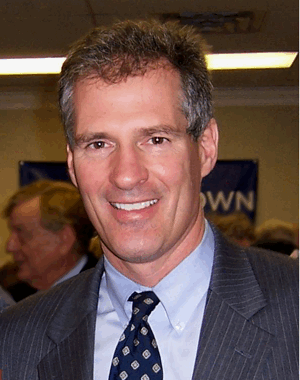
Senator-elect Scott Brown expressed skepticism during his campaign about the human role in global warming. According to the Boston Globe he said, “I think the globe is always heating and cooling. It's a natural way of ebb and flow.”
YOUNG: Massachusetts, the cradle of the American Revolution, just saw another small political revolt. The Senate seat held by the late Democratic liberal lion Ted Kennedy for 47 years went to a Republican, Scott Brown. The dramatic upset gives Republicans 41 seats in the Senate – enough to filibuster legislation, a fact Brown’s supporters celebrated on election night.
[SOUNDS OF CROWD CHANTING “41, 41, 41!”]
YOUNG: Brown’s victory presents a major hurdle to President Obama’s agenda, including a bill to cap greenhouse gas emissions and combat climate change. That bill passed the House but is struggling in the Senate, and that’s where we caught up with Environment and Energy News Senior Reporter Darren Samuelsohn. Darren, 41 – that’s the new math. What does that mean for the climate bill?
SAMUELSOHN: The climate bill was never going to be easy before the Massachusetts election, it got a drop harder just in the simple math with Scott Brown who appears to be a skeptic on the science on climate change and an opponent of federal cap-and-trade policies.
Now, all that said, he’s going to come to Washington and meet a large force in John Kerry, Joe Lieberman, and Lindsey Graham – all of whom have been working for several months to try and come up with some sort of compromise package. But at the same time, moderate Democrats already expressing significant worry that this is not the right time to be focusing on a climate bill, it’s better to be focusing on economic recovery and jobs, a lot of the key focal point issues that you heard in the Massachusetts special election.
YOUNG: And are they casting an eye toward the midterm elections now when they say those things?
SAMUELSOHN: These are senators that are up for re-election and maybe senators who are up in another two or four years – yeah, I think a whole range of Senate Democrats from Carl Levin to Diane Feinstein were all expressing worry about moving forward on a big comprehensive cap and-trade-bill.
You know, the idea of a controversial item like healthcare is something that makes Democrats nervous, but there’s an important distinction to make between healthcare and the climate bill, and that is with healthcare it was largely partisan – the Democrats were trying to move that just with Democrats.

Senator-elect Scott Brown expressed skepticism during his campaign about the human role in global warming. According to the Boston Globe he said, “I think the globe is always heating and cooling. It's a natural way of ebb and flow.”
With the climate and energy bill there’s always been efforts to try and get Republicans, that’s taking into account there were going to be some Democrats were going to vote “no” on this no matter what. Ben Nelson and Mary Landrieu come to mind as the most likely no votes. So, they’ve always been working with the assumption that they needed Republicans and Lindsey Graham was the first to cross over that line. But then beyond that a lot of the Republican possibilities haven’t looked very promising recently.
YOUNG: There’s been some noise about abandoning the cap-and-trade aspect of this and advancing with the other elements of an energy bill instead – do you think that effort maybe has gained steam here?
SAMUELSOHN: It’s gained a little bit of steam. I mean, it’s the most likely alternative to move forward where you’re going to get Republicans support; the problem becomes how many Democrats are going to want to go along on a bill that does cap carbon.
There are a good number of liberal Democrats who have been pushing and pushing and pushing for this for a long time. And see this as their best opportunity; certainly this Congress is probably the greenest Congress you’re ever going to get. You’ve got their champions in the White House and running the federal agencies, and in the key committees, you’ve got speaker Pelosi running the House of Representatives, Henry Waxman in charge of the House energy committee, Barbara Boxer in charge of the Senate environment committee; so, you really couldn’t have had a better lineup to try and get this thing through. And however the politics of this in Washington have always been difficult and they remain difficult, and they’re even more difficult now after this Massachusetts election.
YOUNG: So as the dust begins to settle after this big upset in Massachusetts, what’s your read on the chances for a climate change bill this year?
SAMUELSOHN: You know, I’m going to give the odds maybe 20, 20 percent chance, but maybe even less than that right now. It’s going to be a huge lift for Kerry, Graham, and Lieberman to pull it off. There’s going to need to be a lot of tradeoffs, and then of course whatever they pull off they have to then negotiate with the House, which passed what it passed last year, and that’s a pretty aggressive, sweeping bill so will the House be willing to come back to what the Senate has put forward? And that’s something we’re seeing happen on healthcare, and that’s been difficult for Democrats to just negotiate with Democrats.
YOUNG: Darren Samuelsohn, Senior Reporter for Environment and Energy News, speaking with us from Capitol Hill. Thanks a lot.
SAMUELSON: Thanks for having me.
Related link:
For more on what the Scott Brown will mean for climate change legislation, click here.
[MUSIC: Coupe Cloue “yeye” from Coupe Cloue Live (Melosie Makers Inc 1994)]
YOUNG: The Republican victory in the Senate came just as the Obama administration was marking one year in office. Just ahead we’ll hear a clean energy critique of the president’s first year. Keep listening to Living on Earth.
A Year In, New Ideas for Obama
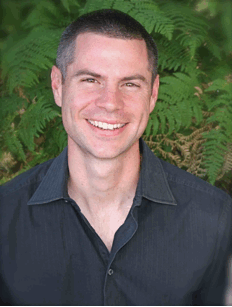
Michael Shellenberger is president and co-founder of the Breakthrough Institute. (Courtesy of the Breakthrough Institute)
YOUNG: It’s Living on Earth, I’m Jeff Young.
President Obama is preparing his first State of the Union address, where he will no doubt point to accomplishments from his first year. His supporters in the environmental arena say there are many: historic new standards for auto fuel efficiency, EPA action to control carbon dioxide emissions, and a new focus on chemical safety. And the President has made cleaner energy a high priority:
OBAMA: From China to India, from Japan to Germany, nations everywhere are racing to develop new ways to produce and use energy. The nation that wins this competition will be the nation that leads the global economy. I'm convinced of that, and I want America to be that nation.
YOUNG: But not all the green reviews of Obama’s first year are positive: a provocative piece in the journal Foreign Policy says Obama promised to launch a green energy revolution but failed. Co-author Michael Shellenberger leads the policy think tank, the Breakthrough Institute.
He says the president erred by expending political capital chasing a cap on carbon emissions, and not spending enough to develop clean energy technology. Shellenberger titled the Foreign Policy article, "The End of Magical Climate Thinking."
SHELLENBERGER: The core of magical thinking about climate change is that we have all the technologies we need and we just need to implement them. Really we have to focus on solving particular technology problems in order to be in a place where it’s not going to cost a lot of money to deal with climate change.
Solar panels have to more efficiently covert sunlight into electricity; nuclear power plants have to become smaller, cheap and safer; biofuels right now, such as ethanol, are really not any better environmentally, some say they are worse, so we need to have much cheaper, much cleaner biofuels; and we need to have batteries that are inexpensive and that requires some basic advances at the level of chemistry so we can store a lot more energy a lot more cheaply in a lot smaller amount of space.
YOUNG: I thought the argument was though that by putting a price on carbon, or by setting a hard cap on emissions reductions, that’s what’s going the drive the investment in those kinds of technologies?
SHELLENBERGER: Yeah, and so the idea has been: well, we have to put a price on pollution because then the private sector will make the investments in the technologies. But what we’ve seen is that even in places like Europe where the price on carbon dioxide pollution reached 40 dollars a ton, Europe continued to build coal plants – and not the new kind that supposedly will capture the carbon pollution and store it underground, but just the same old kind.

Michael Shellenberger is president and co-founder of the Breakthrough Institute. (Courtesy of the Breakthrough Institute)
In other words, it would require a cost on pollution, it would require raising the price of fossil fuels so high that no government in the world is willing to pay that price. The amount that the public is willing to pay in terms of an increase in energy prices has been exaggerated. Really, these are challenges that governments traditionally deal with.
In the space race with the Soviet Union, NASA needed computers, the federal government essentially invented the entire field of computer sciences, funding scholarships; we bought down the price of microchips from a thousand dollars a chip to 20 dollars a chip. You know, we point out that we didn’t get the personal computer through a cap and trade system on typewriters, we didn’t get the Internet by putting a telegraph tax or a fax tax; we create these new technologies and we make them cost competitive directly.
YOUNG: To be fair though, I mean, I think we have to look at the significant investment that has been made here. The Recovery Act alone put tens of billions of dollars toward clean energy R and D, right?
SHELLENBERGER: It did. The Stimulus Act by President Obama was an outstanding first step. But the most important lesson from that is that it really countered the conventional wisdom that the federal government just isn’t going to invest in technologies.
Well I think the stimulus disproved that. It showed that in fact, it’s much more popular for the federal government to invest directly in these technologies. In fact, I think the latest polls show that it’s the most popular of all energy policies. Direct energy R and D spending especially for things like renewables, solar and wind is extremely popular – far more popular than cap and trade or putting a price on carbon dioxide.
YOUNG: Isn’t it possible that this kind of single-minded focus on new technology as the answer is itself a bit of magical thinking?
SHELLENBERGER: The funny thing about climate change is that in contrast to so many other challenges in our society that we haven’t seen it as a technology problem. It’s funny when you think of a problem like Polio, we didn’t say, well we really just have to shut down all the pools permanently, we’re not going to be able to live the way we’ve been living – there was a big effort to find a vaccine, a technological fix. And in fact, even in the environmental community today if you want to criticize somebody you say, well they believe in technological fixes, as though it’s sort of illegitimate or as though it is magical thinking.
In truth, we solve a huge number of the challenges we face as human beings with new technologies, that’s how we’re going to dramatically reduce our emissions to deal with climate change. And so, I think that instead of viewing it magically we need to understand that technological progress is hard, it doesn’t happen automatically with a few new regulations or a price on pollution, that there’s a set of pretty clearly identified problems that energy scientists believe we need to solve. It’s not going to be easy to solve them, where it’s not a single Apollo project; we need several Apollo projects on these big technological challenges.
YOUNG: But with the budgets tight, as they are, is that still a viable option?
SHELLENBERGER: Absolutely. We’re not going to cut our way out of our current fiscal crisis; we’ve got to grow our way out. That’s what we did in the 90’s: we saw the Internet boom, we saw a huge growth in information technologies. That was a result of investments that we were making in the 50’s and 60’s.
We need to be making a much more serious investment today in these new clean energy technologies. There’s definitely going to be a market for them. The world is going to double how much energy it consumes by the middle of the century. Energy is the master resource of the economy. It’s the one thing that you know there’s going to be more demand for.
We can either meet that demand by rising to that challenge and doing the same thing that we know works, or we can kind of continue to engage in this magical thinking, which has led to no action over the last 20 years and really now at the point of being past by China, Japan, and South Korea when it comes to creating these new industries.
YOUNG: Michael Shellenberger is president of Breakthrough Institute and author of a piece that’s in Foreign Policy called “The End of Magical Climate Thinking”. Thanks for your time.
SHELLENBERGER: Hey, thanks for having me.
Related links:
- The Breakthrough Institute
- Foreign Policy Article “The End of Magical Climate Thinking.”
- Click here to hear President Obama’s October 30th speech at MIT
[MUSIC: African Virtuosos “Nanibali” from The Classic Guinean Guitar Group (Sterns Africa 2007)]
Cool Fix for a Hot Planet
YOUNG: Just ahead – some farmed salmon catch a better rating for health and sustainability – but first, this Cool Fix for a Hot Planet from Emily Guerin.
[COOL FIX THEME]
GUERIN: In Taiwan, English teacher John Lamorie made a deal with his students – if they helped him build a new schoolhouse, he would reward them with extra credit. But instead of sawing and hammering, the students brought in old newspapers that Lamorie used to make “papercrete,” a mixture of cement, paper and water.
Papercrete appeals to eco-minded, do-it-yourselfers looking for an inexpensive alternative to concrete. It can be made from almost any kind of paper, can be shaped into blocks or poured into form, and is an excellent insulator.
But papercrete has its drawbacks. The material absorbs water even after being sealed, and is prone to develop mold when wet. Its sponge-like characteristics make it unsuitable in wet climates or for use as a roof.
Papercrete is 20 to 50 percent cement. And with cement plants accounting for five percent of global carbon dioxide emissions, papercrete starts to look a lot less “green.”
Defenders say it keeps waste paper out of landfills, creates energy efficient buildings, and uses a lot less cement than concrete. Still, papercrete remains a marginal construction material.
But teacher John Lamorie is a convert. When he finishes the school he’ll move onto his next papercrete project – a pizza place. That’s this week’s Cool Fix for a Hot Planet. I’m Emily Guerin.
[COOL FIX THEME]
YOUNG: And if you have a Cool Fix for a Hot Planet, we'd like to know it. If we use your idea on the air, we'll send you a sleek electric blue Living on Earth tire gauge. Keeping your tires properly inflated can save you hundreds of dollars a year in fuel. Call our listener line at 800-218-9988, that's 800-218-99-88. Or email coolfix – that's one word – coolfix at l-o-e dot org.
Related link:
Click here for more on papercrete.
Good Fish, Bad Fish
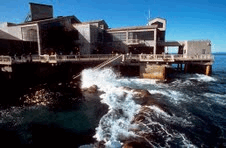
Seafood Watch's headquarters. (Courtesy of the Monterey Bay Aquarium)
YOUNG: For years, environment and health advocates have urged consumers to avoid farm-raised salmon. Two recent developments might muddy the waters around salmon aquaculture: a new study links the contaminants in those fish to insulin resistance – that’s bad. But the influential Seafood Watch gave its first-ever seal of approval to one kind of salmon farming, the practices used by AquaSeed Corporation in Rochester, Washington – that’s good.
Confused? Well, we were too, so we called up Sheila Bowman to sort things out. She’s the senior outreach manager for Seafood Watch at the Monterey Bay Aquarium. Welcome to Living on Earth!
BOWMAN: Thank you, Jeff; it’s great to be here.
YOUNG: Well let’s start with this study on contaminants in farmed salmon. This was published in Environmental Health Perspectives, there’s some link to insulin resistance, which may be a precursor to a type of diabetes. What did we learn here?
BOWMAN: Well I think what that study highlights is within in the environment there’s these persistent, organic pollutants. These are things like the DDT’s and the pesticides that we’ve been using. They’re persistent, they’re not breaking down, they’re not going away, they’re finding their way into first the environment and now into our food system. And these salmon are just kind of one of the places where these end up, and of course we’re interested in and impacted when it’s something we eat.
YOUNG: Why is this of special concern for farmed salmon?
BOWMAN: Well, the thing about farmed salmon is it’s a system where you are raising carnivorous fish in fairly intensive situations, usually pretty highly packed farms with fish. And these farmed fish are really being forced to eat pellets that you find where they’ve taken lots of wild fish, put them into pellets, concentrated any toxins that might be there, and put those out to the fish.

Seafood Watch's headquarters. (Courtesy of the Monterey Bay Aquarium)
YOUNG: And other concerns about farmed salmon, I guess, go beyond the effect on the consumer and health to the effect on the area where the salmon farming takes place.
BOWMAN: Well, exactly, and I think our concern beyond the food quality that comes out of those farms is what are these farms doing to the environment. So, are they situated in a place where they’re having negative impact on the oceans and the fish that live there?
A lot of fish in a small farm make a lot of poop. And if they get a disease then they’re going to get some chemical treatments and antibiotics, and of course farmed salmon have a lot of lice, so there’s the parasite treatment. So there’s a lot farming that goes into the farming of these fish. And when you put their farms just in an open bay where those products can escape into the environment, you know you’ve really got a pretty unpleasant kind of thing to think about with all of that flowing out into the wild.
YOUNG: So lots of problems with aquaculture and salmon. However, your group recently looked at one kind of salmon and gave it the thumbs up. What’s different about that approach to raising salmon?
BOWMAN: Well, we did, and we were pretty pleased to find somebody within the salmon farming industry who was interested in doing things differently.
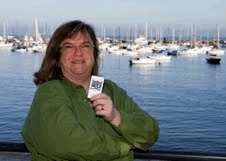
Sheila Bowman of Seafood Watch. (Courtesy of the Monterey Bay Aquarium)
So, rather than positioning the farm out in a bay where all of those products just flow out into the wild, we started seeing some of these farmers moving these farms onshore, putting them into tanks where they’re containing the fish, containing the fish waste; all of those detrimental impacts are now being managed by the farm, so it’s not creating these kind of areas of impact within the wild environment.
YOUNG: And how has that type of salmon farming addressed the health issues and what the salmon are fed?
BOWMAN: These particular salmon are being fed a more mixed diet, so what they’re getting is not just high levels of wild marine fish turned into pellets; they’re getting chicken, they’re getting poultry, which means that they’re not going to get food with a lot of pollutants in it that they’re going to then kind of sequester and carry on in their bodies.
YOUNG: So, fish eating chicken; in this case is not necessarily a bad thing?
BOWMAN: Well, you know fish need protein, if you’re going to raise a carnivorous species, so the challenge is: do you take a lot of wild fish and turn them into pellets to feed your carnivorous fish? Or do you find your protein somewhere else?
YOUNG: So, one farm seems to be taking some positive steps and you’ve decided to give them the thumbs up, does that mean that I, the consumer, should be looking for that source of farmed salmon?
BOWMAN: It’s not quite there yet. I mean we’re excited about the future of this, but consumers are going to have to wait a little while and until then the farmed salmon they see in the market, they pretty much can assume is that traditional farmed salmon that they do want to avoid.
YOUNG: Where do you see aquaculture heading here in the coming years?
BOWMAN: This year we will as a country for the first time be consuming more farmed fish than wild fish. We’ve turned that corner. So how fish are farmed is going to be important to every one of us, not only for the environment that’s impacted but how the fish are raised and what kind of quality of fish is coming out of it.
So, we do see a shift in a movement and a lot of it’s because consumers have become aware and they want to throw their support behind businesses that are doing the right thing.
YOUNG: And your bottom line here has not really shifted, your advice is still pretty straightforward.
BOWMAN: Our advice is still for 99 percent of us out there to avoid farmed salmon. This species that’s coming out in Washington State is going to be very regional in its distribution and it’s not something that’s going to be in the marketplace for at least a few years.
YOUNG: Sheila Bowman with the Monterey Bay Aquarium’s Seafood Watch. Thanks very much.
BOWMAN: Thank you, Jeff.
YOUNG: Check the Seafood Watch list and more at our website l-o-e dot org.
Related links:
- To learn more about the Monterey Bay Aquarium’s Seafood Watch program, click here.
- Click here to view the aquarium’s recommendations for fish that are the most sustainable to eat.
[MUSIC: Andrew Bird: “Skin Is, My” from Itunes Live Sessions (i-tunes 2009)]
Long Live the Kingfisher
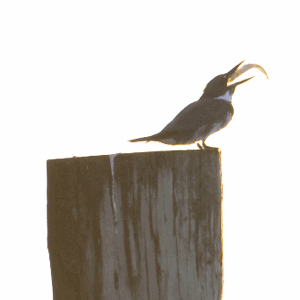
(Photo: (c) Salt Marsh Diary)
YOUNG: When it comes to actually catching fish – humans are amateurs, compared with the kingfisher. And writer Mark Seth Lender finds the belted kingfisher cranky, intolerant, almost impossible to approach, which makes the bird one of his favorites.
LENDER: The mercury is low yet warm for the middle of winter. The sea is calm, the sky clear blue: Kingfisher weather. I know the places he prefers, I know from long experience the times of day. I know where I must bide and where to look so he will be in light and me in shadow. Patience completes the equation. Serendipity the only persuasion might put things right, all in place as they will need to be, before Kingfisher flees.
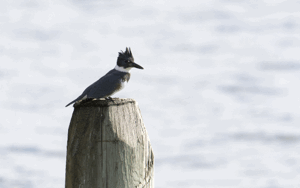
(Photo: (c) Salt Marsh Diary)
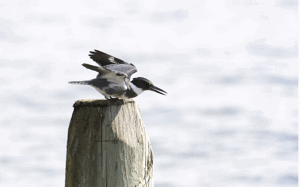
(Photo: (c) Salt Marsh Diary)
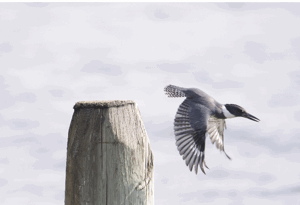
(Photo: (c) Salt Marsh Diary)
Kingfisher visits these same pillars and posts there, just off shore, with regularity. He spots me far down the strand and will not have it. Sometimes if I stand absolutely still he will come, very close. Though never long. A heavy breath will drive him, downshore, three or five or seven hundred yards and further.
Shhh! There he is on the outermost pile, Belted Kingfisher, looking down. He is all attention now; Anchovies clear as drinking straws swim flat and fast just below him and do not know him. One comes. He goes – SPLUNJG! – Then again to his place of mooring, thwack-whacking poor fish senseless. Then pauses. Then tips that too-big-for-his-body Kingfisher head waaaay back – and SLP! – swallows poor fish whole. Then sits, digesting bits of scale and fin.
Beneath the white belt about his neck, Belted Kingfisher’s little belly squats above splayed feet, more like a bird who pecks wood for a living and eats un-nautical things. The heavy beak; the pattern of his flight; Old Kingfisher seems closer to that Flicker who clings to the vertical of a nearby pine than to those great and usual eaters of fishes, Eagle and Osprey, Cormorant and Penguin.
East from Argentina to Africa, north and south and all the way to Costa Rica, all these lands Kingfisher knows. Among these many places in his many ways he comes from a single source, unique.

(Photo: (c) Salt Marsh Diary)
Cover to cover, I creep toward the perfect point of vantage. I hold my breath; I am stone; no matter – Kingfisher flies. Proximity is his fuse and I am the match. Looking over his shoulder he waves goodbye, Flap-flap-flap-flap glide, Flap-flap-flap glide, chattering his irritation.
However hard I try there is no besting the Fisher of Kings, and his wise, sharp eye.
[MUSIC: Cyrus Chestnut “All Creatures Of Our God And King” from Spirit (Jazz Legacy Productions 2009)]
YOUNG: Mark Seth Lender observes kingfishers and other wildlife near his home on the Connecticut coastline. He also writes a syndicated column called “Salt Marsh Diary” and takes some nice photos – you can see some of them at our website l-o-e dot org.
[MUSIC: Cyrus Chestnut “All Creatures Of Our God And King” from Spirit (Jazz Legacy Productions 2009)]
YOUNG: Coming up: a few shortcuts to Walden – that’s just ahead on Living on Earth.
Listener Letters
YOUNG: It’s Living on Earth, I’m Jeff Young.
[LISTENER LETTERS THEME; TYPEWRITER SOUNDS]
YOUNG: Time now – to hear from you. Our two special, holiday shows drew a lot of listener response – both kudos and criticism.
“I just listened to your New Year’s storytelling special,” writes Colleen Anderson of Charleston, West Virginia.
“The stories were exquisite and educational. This is one of the best things I have heard on radio recently.”
Thanks Colleen!
Storyteller Jay O’Callahan’s love letter to NASA, “Forged in the Stars,” inspired this love letter from WCPN Cleveland listener Terre Maher.
MAHER: I love giving the task of interpreting science to a poet-storyteller. It is moving and touching and learning about the voyager and putting a “hello” in so many languages. I just thought it was a really, really cool piece. And thank you for putting it on.
YOUNG: Our storytelling specials didn’t please everyone. Listener Patrick White of Washington, DC signed his email “Very disappointed”. He questioned why we produce our annual story telling shows at all. “According to your broadcast history,” writes Patrick, “environmental concerns are only operative 50 weeks a year.”
And we got an earful about our story on creating new sounds for silent electric cars. Ken Fisler another WCPN listener writes: “it might be interesting to allow electric car owners to upload a sound of their own choosing into the warning system. It could be a selling point for prospective car buyers.”
When Shawn Snow, who hears us on KUAR in Little Rock, Arkansas, heard that story, it took her back to the future, and one of her favorite TV shows from the 60’s.
SNOW: The Jetsons. George Jetson’s flying car.
YOUNG: And do you remember what that sounds like? Can you do it for us?
SNOW: Oh, gosh! [Laughs]
[SNOW MAKES BBBBRRRRRLLLLLL SOUND]
SNOW: Something like that.
YOUNG: That’s pretty good!
[SOUNDS OF JETSONS’ FLYING CAR]
YOUNG: It’s happy. It’s kind of like chirping little bird or something.
SNOW: It is; and it’s something that’s not frightening and we recognize it as a vehicle of some kind. And it just makes me happy.
YOUNG: Do you happen to remember the Jetson's household robot’s name?
SNOW: No…Roy, Elroy? No, that was the kid.
YOUNG: ‘Our boy, Elroy.’
SNOW: Yeah, and Jane his wife, and the teenager – gosh, what was the robot’s name? I don’t remember.
YOUNG: Rosie.
SNOW: Rosie! How could I forget?
YOUNG: Well, as Rosie was fond of saying: back to work.
[ROBOT ROSIE SAYING, “Back to work, back to work, everybody, work, work, work, work”]
SNOW: That’s it – back to work.
YOUNG: Thank you very much!
SNOW: Sure, nice talking to you.
YOUNG: Well, if you have any comments on our work – let us know. You can reach us at comments @ l-o-e dot org. Once again, comments @ l-o-e dot o-r-g. Our postal address is 20 Holland Street, Somerville Massachusetts, 0-2-1-4-4. And you can call our listener line, at 800-218-99-88. That's 800-218-9-9-8-8.
[END LISTENER LETTERS THEME]
Walden by Haiku
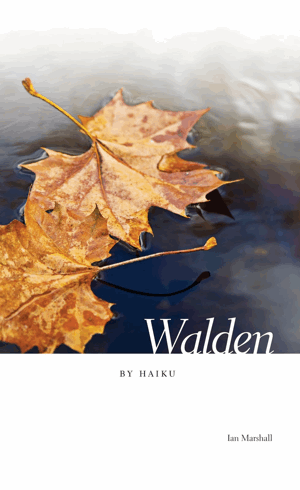
Professor’s Marshall’s new book that rewrites Thoreau’s Walden in haiku form.
YOUNG: Henry David Thoreau’s “Walden,” published in 1854, is an acknowledged classic of American literature and one you probably know well. But you’ve probably not heard “Walden” quite like this. It’s a new version by Penn State-Altoona English and environmental studies professor, Ian Marshall. Hello, Professor Marshall.
MARSHALL: Hello!
YOUNG: Professor Marshall, I’m hoping you can start us off by reading an excerpt from your “Walden”.
MARSHALL: Okay, I’ll keep it brief:
If I could ever find the twig
THE twig
The robin sits upon.
And you might notice that takes the form of a haiku.
YOUNG: A haiku? And the book is, “Walden by Haiku.”
MARSHALL: Yep. What I did in the book is I have some haiku that I extracted from the text of “Walden.”
YOUNG: And these are the actual words from Thoreau that you’ve taken and sort of made them more spare?
MARSHALL: Yeah.
YOUNG: Why haiku? What is it about the aesthetic of haiku that you find in Thoreau?
MARSHALL: Well, let us count the ways! First, there’s the aesthetic of simplicity, simplicity of language, simplicity of theme, simplicity of lifestyle. There’s the focus on the seasons. Some say that haiku is not so much a kind of nature poetry, but a poetry specifically about the seasons. And of course that’s the organizing principle of “Walden.”
There’s a reliance on images of nature as Thoreau goes through “Walden” it’s more and more focused on images of nature with less and less philosophical explanation. There’s a view of nature as a realm of the unchanging and the ever changing, focusing on what’s eternal in the natural world but also what’s ephemeral, that’s large scale and small scale. So there’s a whole set of aesthetic principles of haiku that seem to be demonstrated unintentionally, of course, on Thoreau’s part in “Walden”.
YOUNG: Because he never read a haiku, right?
MARSHALL: No, none were available, he wouldn’t have known about it. He was interested in Eastern thought, but there simply were not any translations of haiku in English at the time.
YOUNG: And yet, he arrived at a kind of similar approach to writing about nature and how he and we relate to nature.
MARSHALL: Yeah, and I think it comes from looking closely into the natural world and into seeing that all the little details of the natural world are somehow fraught with significance.
And it’s sensing, too, that to live a simple life is paradoxically a very rich kind of life and a haiku specializes in that kind of paradox -- to look at simple things that are meaningful, this is a principle called wabi. And the idea is that in material poverty –life without fancy things – there’s a kind of spiritual richness. I think Thoreau sensed that living there by the side of Walden Pond. I think writers of haiku sense the same thing.
YOUNG: If there’s one thing that those of us who read “Walden” in high school or college remember from it it’s probably: “simplify, simplify.” And that’s it, that’s “wabi,” isn’t it?
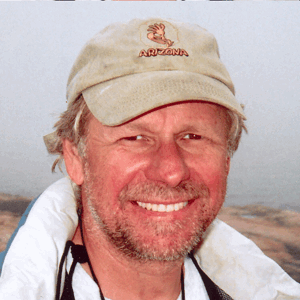
Ian Marshall, professor of English at Penn State Altoona
MARSHALL: Yep, that’s exactly it. In fact, in the epigraph to my book, I took that idea of simplifying – it’s the line he has in his first chapter called “Economy” where Thoreau says, “Shall we always study to obtain more of these things and not sometimes to be content with less?” Haiku is all about being content with less, because it’s so few words and it’s so, so short, and so small, and so simple, and yet there’s something magnificent about those few simple words.
YOUNG: Can you read us a haiku that you extracted from the “Economy” section of “Walden”?
MARSHALL: No curtains
No gazers to shut out
But the sun and the moon.
YOUNG: Mm hmm.
MARSHALL: So he lived in his cabin, he didn’t need any curtains because there’s nobody around but the sun and the moon.
YOUNG: There’s also this notion that solitude is important in haiku.
MARSHALL: Absolutely, the Japanese term for that is sabi – s-a-b-i – and of course, Thoreau has a chapter called “Solitude” and in the Japanese principle, it’s sometimes translated as aloneness. And there’s something melancholy about that, but there’s also something beautiful because it’s in moments when we’re alone in a natural world that we may most be attuned to the beauty of the natural world.
YOUNG: And in many cases, the source material from “Walden,” it’s not that far away from the haiku that you crafted from it. I mean he was really close to haiku in some moments, in some descriptions, wasn’t he?
MARSHALL: Oh, absolutely. It’s because he thought that the stuff of the natural world was worth observing closely, and worth commenting on, and worth recording. And I think, like a haiku writer, they sense that we don’t need to explain a whole lot, we just need to present it. And often in haiku you juxtapose two images, you set them next to each other and let them reverberate.
YOUNG: I was hoping you could give us a couple of the poems along with the excerpts from the original, from “Walden”?
MARSHALL: Sure. Here’s one from Spring:
The first sparrow
Faint silvery warblings
Over bare fields.
And that seems to me the essence of that whole chapter on spring, it’s the excitement! And here’s the original:
“The first sparrow of spring! The year beginning with younger hope than ever. The faint, silvery warblings heard over the partially bare and moist fields from the bluebird, the song sparrow, and the redwing as if the last flakes of winter tinkled as they fell.”
So you can see, I cut out stuff, but the bits I used were all there in a couple of sentences by Thoreau. So, I’m essentially stealing from him! [Laughs]
YOUNG: [Laughs] I think it’s called an homage.
MARSHALL: [Laughs] Right, and I’m giving him credit.
YOUNG: Yeah, oh, sure.
Professor, you also found parallels here between what Thoreau was doing at Walden and what a Japanese haiku master Basho did at a pond a century earlier.

Professor’s Marshall’s new book that rewrites Thoreau’s Walden in haiku form.
MARSHALL: Basho was probably the most famous haiku writer of all, perhaps the most famous writer in Japanese literature. And interestingly enough probably his most famous haiku is about a pond, and of course “Walden” is about Thoreau living by the side of a pond. Basho’s haiku about the pond is:
The old pond
A frog jumps
The sound of water
The point for Basho was – among many possible points – is that this is the moment when he realized haiku doesn’t have to be about the spectacular, it doesn’t have to be about a magnificent mountain vista or a waterfall. It can be something as simple as an old pond and a frog jumping, and in that simplicity, in that attunement to taking in the simplicity of the natural world, that’s where the beauty of a haiku comes.
YOUNG: It is remarkable, these two writers, two poets separated by an ocean, a language, more than a century in time, and yet they arrived at very similar ways of trying to describe nature.
MARSHALL: Yeah, and it’s about paying attention. I actually do a haiku lesson in an environmental studies class that I team-teach with a biologist. And we’re interested in tracing – gee, what connections can there be between poetry and biology.
And one thing we talk about in reference to haiku is that just as a scientist begins, even before a scientist constructs a hypothesis, begins with just observing: What do you see?
Well, that’s where a poet begins, too. So, you begin before you decide what things mean, you begin by observing. Why do people like Basho and Thoreau have something similar in the way that they look at the natural world? I think because they paid attention and they delighted in the attention they paid to the natural world.
YOUNG: Do you have a favorite from your haiku?
MARSHALL: Oh, I’ve got a bunch of them actually. Here’s one from “The Bean Field”:
Tonight
My flute has waked echoes
Over the pond.
Here’s another one, it’s kind of sad and lonely, but it’s also – there’s something very beautiful. You wonder about those echoes, is it memories; is it a yearning for a friend, a companion?
We don’t know, but it’s just this beautiful sort of melancholy image.
YOUNG: Have you visited Walden Pond?
MARSHALL: Yeah, yeah.
YOUNG: You know, my experience there is there’s a strong sense of irony. When you go there, especially if you happen to visit on a warm weekend in the summer. It’s thick with people the path is fenced off, so that you actually can’t get to the pond. It’s ain’t like Thoreau saw it.
MARSHALL: [Laughs] That’s for sure. Yeah, my initial impression when I got there was, you know, “Holy crap, what have they done to this place?” I mean look at all the people! Smell all the suntan oil.
But, I also found once you leave the public beach and start making your way around the pond, by the time you get to the other side I think I saw a birdwatcher or two, took a swim with some ducks. So, you just move away from the public beach and you can experience some of the solitude Thoreau might have felt there.
YOUNG: What do you think Henry David Thoreau might make of your book?
MARSHALL: [Laughs] Well, he was a pretty cantankerous guy, we understand. I hope he would be pleased that someone was so interested in what he had to say that they wanted to dwell on his words to this extent – to shape it into a different literary form. But, I imagine he would have been sympathetic to the goals of haiku and to the practice of haiku. People often say that his poetry wasn’t as wonderful as his prose. If he’d had access to haiku, if he’d known about haiku maybe that would have been his poetic genre.
YOUNG: Professor Ian Marshall, the book is called “Walden by Haiku.” Thank you very much for your time.
MARSHALL: Oh, thank you.
Related link:
To learn more about Professor Ian Marshall’s work, visit his webpage.
[MUSIC: Jeremy pelt “Haiku” from Identity (MaxJazz 2005)]
Remembering Ted Stanley
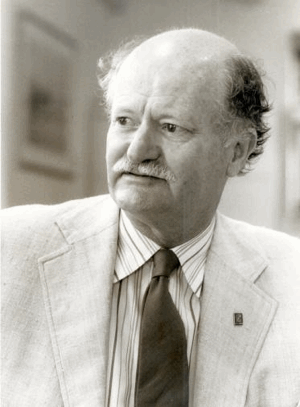
YOUNG: If you are a regular listener to our program, you’ve probably noticed that our broadcasts come from the Jennifer and Ted Stanley studios here in Somerville, Massachusetts. And so,\ it is with sorrow that we have to report that Ted has died at the age of 85, after a long illness, and a long history of environmental and journalism philanthropy. Living on Earth’s Steve Curwood has this remembrance.
CURWOOD: I’d heard about Ted Stanley long before I met him – all those underwriting credits on NPR for many years, thanking Jennifer and Ted Stanley. But I wasn’t prepared for the unassuming yet highly curious man I first met on a hike in the White Mountains of New Hampshire more than a decade ago. He was already slowing down a bit, but he was still eager to “change the world for the better,” says his widow Jenny.
As a young man he had seen the world in one of its worst moments. Even though he went to an elite private school and Princeton, Ted Stanley enlisted in World War Two as a private, the lowest rank.
Late in the war he wound up on the front lines at the Battle of the Bulge, a last ditch effort by the Germans to hold back the U.S. and Britain, and fought in bitter cold.
At one point he was wounded, not badly, but enough to head back to get bandaged up.
He was walking alone looking for the medics when he encountered a single German soldier.
Both men were armed; both men were at the edge of a bloody battlefield littered over time with thousands of casualties.
Both men looked at each other, kept their weapons lowered, and walked on without a word – or a shot being fired.

It seems that was the day Ted’s philosophy crystallized: no matter what the history, the anger, the fight, in the end we are all humans – a part of creation, each part due care and respect.
After the war Ted Stanley made a lot of money running Bowne & Company, a firm that prints stock certificates for Wall Street. An avid sailor, he retired to a home on the Chesapeake Bay in 1981. But he quickly learned that the Bay and the working community around it were in distress. The Chesapeake is our backyard, he told his wife.
He found a scientist, got directed to the Chesapeake Bay Foundation as an environmental group that was taking action, and made his first large donation.
He also funded youth programs. Ted soon set up the Town Creek Foundation to formalize his gift giving, and many more donations would follow. Interest in public radio came from Jenny, and their combined interests led to support many ventures, including Living on Earth’s Jennifer and Ted Stanley studios.
But I think Ted Stanley’s greatest legacy was the embodiment of the philosophy he embraced that day in the war, and his commitment to try to end what at times seems like humanity’s war against nature.
Ted Stanley may be gone, but he’ll never be forgotten by so many of us.
[MUSIC: Jenny Scheinman “Awful Sad” from Crossing The Field (Koch Records 2009)]
YOUNG: Living on Earth’s Steve Curwood.
[MUSIC CONTINUES]
YOUNG: On the next Living on Earth – a cool idea from Denmark: A new system to air-condition the city of Copenhagen, it’s more than a zero sum game.
MAN: Actually in Denmark we have periods when the electricity is not only zero it will turn into a price of minus, which means you gain money using electricity. Sounds crazy. So I mean this is interesting, yes?
YOUNG: Yeah! Keeping houses and the planet cool – next time on Living on Earth.
[WALTZ]
YOUNG: We leave you this week with a chilly afternoon serenade.
[STREET MUSIC: Music recorded on the streets of Copenhagen by Producer Eileen Bolinsky during COP15 in December 2009]
YOUNG: Winter darkness comes early in Denmark, but the lack of light and bitter cold did not stop this six-man band from warming up a crowd of onlookers. The four string musicians, keyboardist and accordion player bundled up in old wool coats, and fingerless gloves. Living on Earth’s Eileen Bolinsky recorded them on Stroget – Europe’s oldest and longest pedestrian shopping street.
|
|
[MUSIC CONTINUES]
YOUNG: Living on Earth is produced by the World Media Foundation. Our crew includes Bobby Bascomb, Eileen Bolinsky, Bruce Gellerman, Ingrid Lobet, Helen Palmer, Jessica Ilyse Smith, Ike Sriskandarajah, and Mitra Taj, with help from Sarah Calkins, Marilyn Govoni and Sammy Sousa. Our interns are Emily Guerin and Bridget Macdonald. Jeff Turton is our technical director. Alison Lirish Dean composed our themes. Steve Curwood is our Executive Producer. You can find us anytime at l-o-e dot org. I’m Jeff Young. Thanks for listening.
ANNOUNCER: Funding for Living On Earth comes from the National Science Foundation supporting coverage of emerging science. And Stonyfield farm, organic yogurt and smoothies. Stonyfield pays its farmers not to use artificial growth hormones on their cows. Details at Stonyfield dot com. Support also comes from you, our listeners. The Ford Foundation, The Town Creek Foundation, The Oak Foundation—supporting coverage of climate change and marine issues. And Pax World Mutual Funds, integrating environmental, social, and governance factors into investment analysis and decision making. On the web at Pax world dot com. Pax World for tomorrow.
ANNOUNCER 2: PRI – Public Radio International
Living on Earth wants to hear from you!
Living on Earth
62 Calef Highway, Suite 212
Lee, NH 03861
Telephone: 617-287-4121
E-mail: comments@loe.org
Newsletter [Click here]
Donate to Living on Earth!
Living on Earth is an independent media program and relies entirely on contributions from listeners and institutions supporting public service. Please donate now to preserve an independent environmental voice.
NewsletterLiving on Earth offers a weekly delivery of the show's rundown to your mailbox. Sign up for our newsletter today!
 Sailors For The Sea: Be the change you want to sea.
Sailors For The Sea: Be the change you want to sea.
 Creating positive outcomes for future generations.
Creating positive outcomes for future generations.
 Innovating to make the world a better, more sustainable place to live. Listen to the race to 9 billion
Innovating to make the world a better, more sustainable place to live. Listen to the race to 9 billion
 The Grantham Foundation for the Protection of the Environment: Committed to protecting and improving the health of the global environment.
The Grantham Foundation for the Protection of the Environment: Committed to protecting and improving the health of the global environment.
 Contribute to Living on Earth and receive, as our gift to you, an archival print of one of Mark Seth Lender's extraordinary wildlife photographs. Follow the link to see Mark's current collection of photographs.
Contribute to Living on Earth and receive, as our gift to you, an archival print of one of Mark Seth Lender's extraordinary wildlife photographs. Follow the link to see Mark's current collection of photographs.
 Buy a signed copy of Mark Seth Lender's book Smeagull the Seagull & support Living on Earth
Buy a signed copy of Mark Seth Lender's book Smeagull the Seagull & support Living on Earth


